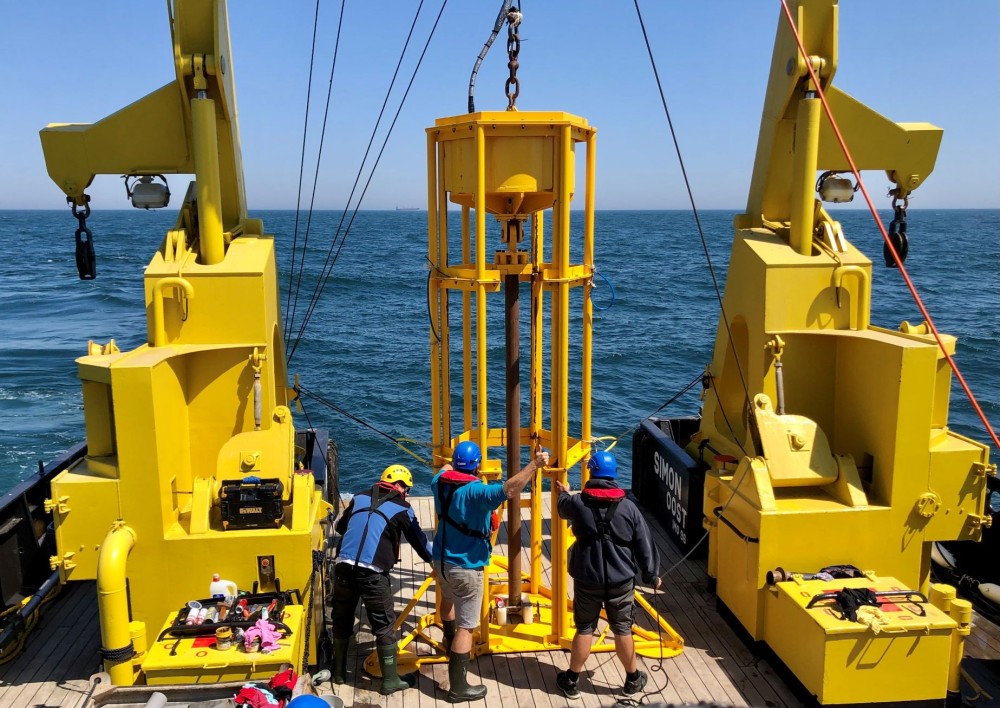In recent years, there has been a strong growing interest and international cooperation in geoarchaeological research of the continental shelf. This new and challenging field of research integrates the study of climate and sea level change, palaeogeography and palaeolandscape, prehistoric archaeology, and human presence and migration routes in the North Sea. That area was once largely land but is now buried under the seabed (cfr EMB Position Paper 21 'Land Beneath the waves - submerged landscapes and sealevel change'). VLIZ is one of the pioneers in Belgium and Europe of this pre-eminently interdisciplinary research field that brings together exact sciences and humanities.

The 'Seascapes Past and Future' research group wants to expand geoarchaeological research in the North Sea in a groundbreaking way, in close cooperation with domestic and foreign research institutes. There are three main lines of research: (1) Reconstruction of drowned landscapes. How did the palaeolandscape in the southern North Sea change during the Late Quaternary (roughly the last 150,000 years)? What has been preserved of these landscapes, including traces of human presence; (2) High-tech research based on acoustic imaging of the seabed. How can we spatially map and visualise buried (archaeological) structures and objects in as much detail as possible? (3) Exploration of the coastal nearshore zone. Characterisation of sediments and depositional layers. How has the coastline and coastal plain evolved over the past 7000 years? What effect did this have on humans and vice versa?
For this research, VLIZ makes maximum use of its extensive infrastructure (RV Simon Stevin, acoustic equipment, vibrocore, etc.). In addition, the VLIZ Robotics Centre deploys autonomous vessels (ROV, AUV, USV) for efficient exploration of the seabed and (shallow) subsurface.
Contact: Dr Tine Missiaen (Tine.Missiaen@vliz.be)
Recent and relevant publications
- Cohen, K.M., Cartelle, V., Barnett, R., Busschers, F.S., Barlow, N.L.M., 2022. Last Interglacial sea-level data points from Northwest Europe. Earth Syst Sci Data 14, 2895–2937. https://doi.org/10.5194/essd-14-2895-2022
- García-Moreno, D., Vandorpe, T., De Clercq, M., Roche, M., Vertino, A., Missiaen, T., 2021. Characterisation of Middle–Late Pleistocene groove-and-ridge landforms incised across the Dover Strait. Geomorphology 376, 107517. https://doi.org/10.1016/j.geomorph.2020.107517
- Giglio, C., Benetti, S., Plets, R.M.K., Dunlop, P., Ó Cofaigh, C., Sacchetti, F., Salomon, E., 2022. Character of advance and retreat of the southwest sector of the British-Irish Ice Sheet during the last glaciation. Quat Sci Rev 291, 107655. https://doi.org/10.1016/j.quascirev.2022.107655
- Mestdagh, T., Lobo, F.J., Llave, E., Hernández-Molina, F.J., García Ledesma, A., Puga-Bernabéu, Á., Fernández-Salas, L.-M., Van Rooij, D., 2020. Late Quaternary multi-genetic processes and products on the northern Gulf of Cadiz upper continental slope (SW Iberian Peninsula). Mar Geol 427, 106214. https://doi.org/10.1016/j.margeo.2020.106214
- Missiaen, T., Fitch, S., Harding, R., Muru, M., Fraser, A., De Clercq, M., Moreno, D.G., Versteeg, W., Busschers, F.S., van Heteren, S., Hijma, M.P., Reichart, G.-J., Gaffney, V., 2021. Targeting the Mesolithic: Interdisciplinary approaches to archaeological prospection in the Brown Bank area, southern North Sea. Quaternary International 584, 141–151. https://doi.org/10.1016/j.quaint.2020.05.004
Projects
2022-2024. MIRICLE: Mine Risk Clearance for Europe. Funded by EU EDIDP. Coordinated by Naval Group Belgium.
2023-2025. CLAY TECONICS: Influence of clay tectonics in the North Sea on offshore wind foundation design and installation. Funded by VLAIO. Coordinated by VLIZ.
2019-present. DEEP HISTORY: Revealing the palaeolandscape of the southern North Sea. Internal VLIZ Funding. Coordinated by VLIZ.
2020-present. Palaeolandscape of the Scheur. Internal VLIZ funding. Coordinated by VLIZ.
2023-2029. Life on the Edge: Studying the coastal zone of the Late Palaeolithic. Funded by UKRI Future Leaders Fellowship (UK). Coordinated by Bradford University (UK).
2023-2027. Taken at the Flood: ensuring sustainable heritage strategies for green energy development in the North Sea. Funded by AHRC (UK). Coordinated by Bradford University (UK).
2021-present. Archaeological desktop studies in the Princess Elisabeth windfarm zone. Funded by FOD Economie. Coordinated by Periplus (NL).
